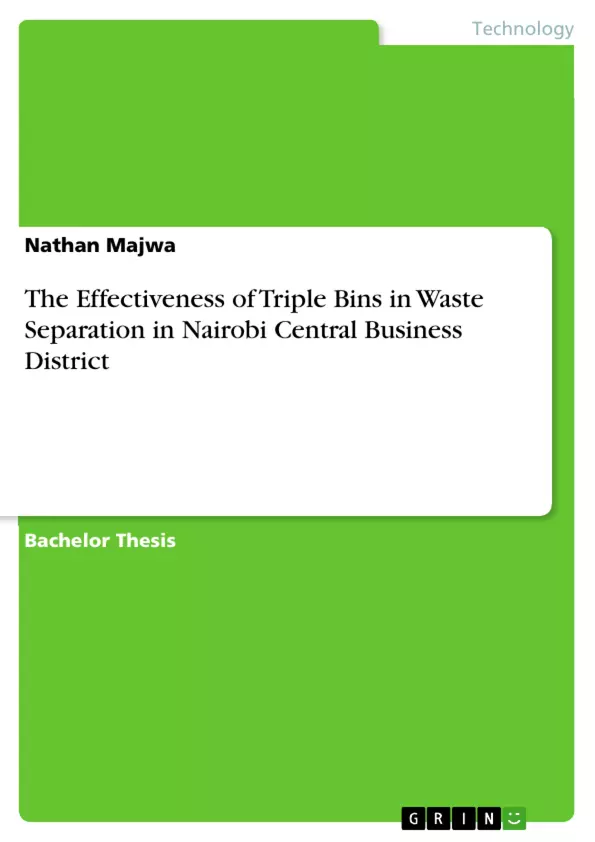This project’s aim was assessing the effectiveness of these bins in waste separation. Data was collected through weighing of the waste found in the bins and questionnaires were also administered to the members of the public in an effort to assess their view of this initiative. The findings showed that many people in the Central business unit preferred to use the triple bins in waste disposal. However, there was very minimal separation of waste into their respective bins. The findings were shared with the County Government of Nairobi and recommendations proposed to enable the County to improve in its waste management practices.
Waste management is increasingly becoming a major challenge in Kenya due to increasing human population and rise of urban centers. Nairobi city being the major City in Kenya has to deal with the challenges that comes about with solid waste by coming up with innovative ideals of waste collection, separation, processing and recycling. One of the innovative ideas of separating waste is the Triple Bin initiative that is an initiative of the County Government of Nairobi. This initiative is however spreading to other towns like Kisumu, Mombasa and Nakuru.
Inhaltsverzeichnis (Table of Contents)
- CHAPTER ONE
- 1.1 INTRODUCTION.
- 1.2JUSTIFICATION AND STATEMENT OF THE PROBLEM
- 1.3 Hypothesis.........
- 1.4 Research Questions.
- 1.5 Research Objectives.
- 1.5.1 Specific objectives.
- CHAPTER TWO .....
- 2.0 LITERATURE REVIEW .
- 2.1 History of Nairobi
- 2.2 Challenges of waste management in Nairobi..
- 2.3 Interventions to the challenges...
- 2.4 Introduction of Triple bins.......
- CHAPTER THREE
- 3.0 MATERIALS AND METHODS.
- 3.1 Description of the Study Area.
- 3.2 Study Design and data collection.
- CHAPTER 4
- 4.0 RESULTS
- 4.1: Effectiveness of triple bins in waste separation.......
- 4.1.1 Anniversary Towers...
- 4.1.2 General Post Office (G.P.O)..
- 4.1.3 Kencom
- 4.2 Determination of the public perception on the triple-bins initiative..
- CHAPTER 5
- DISCUSSION, CONCLUSION AND RECOMMENDATION.
- 5.1 DISCUSSION
Zielsetzung und Themenschwerpunkte (Objectives and Key Themes)
This research project investigates the effectiveness of triple bins in waste separation within Nairobi's Central Business District. The study aims to evaluate the impact of this initiative on waste management practices, analyze public perception, and provide recommendations for its improvement.
- Effectiveness of triple bins in waste separation
- Public perception of the triple bins initiative
- Challenges of waste management in Nairobi
- Interventions to improve waste management practices
- Recommendations for enhancing the effectiveness of triple bins
Zusammenfassung der Kapitel (Chapter Summaries)
Chapter One introduces the research topic, outlining the justification, problem statement, research questions, and objectives. It sets the stage for the study, highlighting the importance of effective waste management in Nairobi.
Chapter Two delves into the relevant literature, providing historical context, exploring challenges of waste management in Nairobi, reviewing past interventions, and introducing the concept of triple bins. It establishes a theoretical foundation for the research.
Chapter Three describes the study area, outlining the research design and data collection methods employed. It provides details on the methodology used to investigate the effectiveness of triple bins.
Chapter Four presents the results of the study, focusing on the effectiveness of triple bins in waste separation at various locations within the Central Business District. It analyzes data on waste separation practices and public perception.
Schlüsselwörter (Keywords)
This research project centers on the concepts of waste management, waste separation, triple bins, public perception, effectiveness, and sustainability. It focuses on the Nairobi Central Business District as the study area and emphasizes the importance of sustainable waste management practices.
- Quote paper
- Nathan Majwa (Author), 2015, The Effectiveness of Triple Bins in Waste Separation in Nairobi Central Business District, Munich, GRIN Verlag, https://www.grin.com/document/505477



